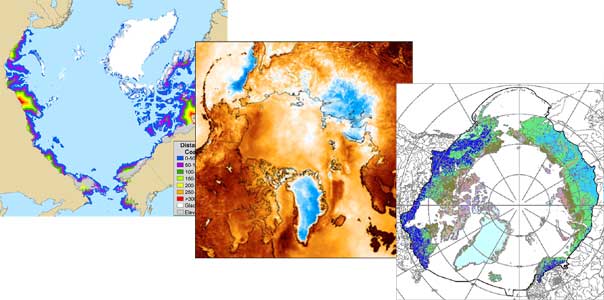
Synthesis of Arctic System Science: Greening of the Arctic
The project is a component of the Synthesis of Arctic System Science program within the National Science Foundation. It will directly address the question of how the terrestrial vegetation of the Arctic has responded to climate change to date and how it will respond in the future as portions of the Arctic Ocean become seasonally ice free as indicated by current understanding of trends in sea ice.
An average 17% increase in greenness, as measured by the normalized difference vegetation index (NDVI), occurred in northern Alaska from 1981 to 2001, concomitant with strong ice retreat in the Beaufort Sea and rising land-surface temperatures. The trend in NDVI is consistent with observations regarding shrub cover, modeling, and experimental evidence linking temperature increases to biomass increases. We will synthesize 23+ years of data from Earth-orbiting satellites in combination with detailed circumpolar maps of climate, vegetation, terrain, and substrate variables to determine how the ocean and land have interacted during the years of record, and then use this information to improve existing models of Arctic vegetation change. We will primarily use a time series of surface temperature, sea-ice, and NDVI data from the Advanced Very High Resolution Radiometers (AVHRR) aboard the NOAA satellites. A host of other remote sensing data will compliment these to extend the length of the record and to look at finer scale changes.
The primary region of study is the circumpolar Arctic as defined by the presence of tundra vegetation and an Arctic climate. A larger area defined by the arctic watershed will be studied in less detail. We will create a circumpolar integrated geographic information system for this region. The NDVI patterns will be analyzed spatially and temporally with respect to mapped variables including land-surface temperatures (LSTs), sea-ice patterns, the age of the terrain, substrate, topography, elevation, and regional floras. We will use vegetation change models to determine if the greening detected thus far can be used to project future patterns of vegetation change in the Arctic. A spatial analysis using BIOME4, a global model of vegetation change, will predict changes in the patterns of arctic and boreal plant communities, and ArcVeg, a model of arctic vegetation dynamics, will link the changes detected using remote sensing to ground-based measurements of plant-species composition and structure to examine the rates at which changes can be expected.
